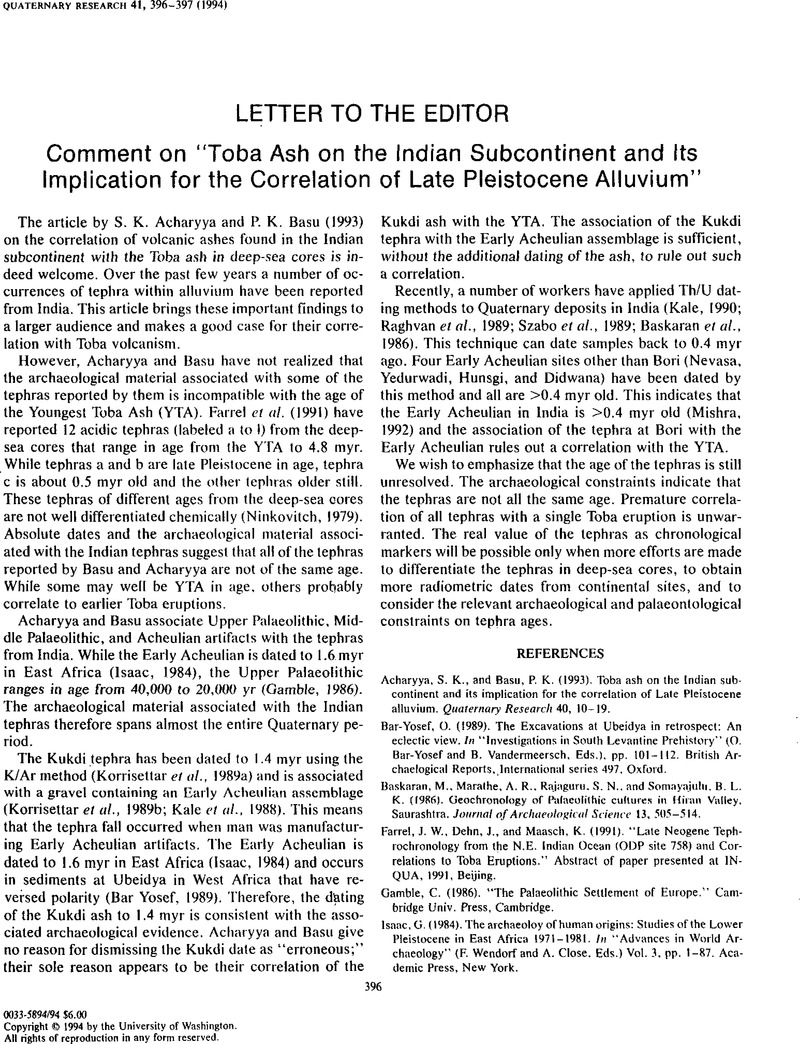Crossref Citations
This article has been cited by the following publications. This list is generated based on data provided by Crossref.
Sankhyan, A.R.
1997.
Fossil clavicle of a Middle Pleistocene hominid from the Central Narmada Valley, India.
Journal of Human Evolution,
Vol. 32,
Issue. 1,
p.
3.
Westgate, John A.
Shane, Philip A.R.
Pearce, Nicholas J.G.
Perkins, William T.
Korisettar, Ravi
Chesner, Craig A.
Williams, Martin A.J.
and
Acharyya, Subhrangsu K.
1998.
All Toba Tephra Occurrences across Peninsular India Belong to the 75,000 yr B.P. Eruption.
Quaternary Research,
Vol. 50,
Issue. 1,
p.
107.
Westaway, Rob
Bridgland, David
and
Mishra, Sheila
2003.
Rheological differences between Archaean and younger crust can determine rates of Quaternary vertical motions revealed by fluvial geomorphology.
Terra Nova,
Vol. 15,
Issue. 5,
p.
287.
Bridgland, David
Maddy, Darrel
and
Bates, Martin
2004.
River terrace sequences: templates for Quaternary geochronology and marine–terrestrial correlation.
Journal of Quaternary Science,
Vol. 19,
Issue. 2,
p.
203.
Petraglia, Michael D.
and
Allchin, Bridget
2007.
The Evolution and History of Human Populations in South Asia.
p.
1.
Jones, Sacha C.
2007.
The Evolution and History of Human Populations in South Asia.
p.
173.
Bridgland, David R.
and
Westaway, Rob
2008.
Preservation patterns of Late Cenozoic fluvial deposits and their implications: Results from IGCP 449.
Quaternary International,
Vol. 189,
Issue. 1,
p.
5.
Bednarik, Robert G.
2011.
The Human Condition.
p.
145.
WESTAWAY, ROB
MISHRA, SHEILA
DEO, SUSHAMA
and
BRIDGLAND, DAVID R
2011.
Methods for determination of the age of Pleistocene tephra, derived from eruption of Toba, in central India.
Journal of Earth System Science,
Vol. 120,
Issue. 3,
p.
503.
Mark, Darren F.
Petraglia, Michael
Smith, Victoria C.
Morgan, Leah E.
Barfod, Dan N.
Ellis, Ben S.
Pearce, Nick J.
Pal, J.N.
and
Korisettar, Ravi
2014.
A high-precision 40Ar/39Ar age for the Young Toba Tuff and dating of ultra-distal tephra: Forcing of Quaternary climate and implications for hominin occupation of India.
Quaternary Geochronology,
Vol. 21,
Issue. ,
p.
90.
Bednarik, Robert
2014.
Pleistocene Palaeoart of the Americas.
Arts,
Vol. 3,
Issue. 2,
p.
190.
Li, Hao
Lotter, Matt G.
Kuman, Kathleen
Lei, Lei
and
Wang, Wei
2021.
Population dynamics during the Acheulean at ~0.8 Ma in East and Southeast Asia: Considering the influence of two geological cataclysms.
Palaeogeography, Palaeoclimatology, Palaeoecology,
Vol. 562,
Issue. ,
p.
109927.
Deo, Sushama G.
Baptista, Andre
and
Rajaguru, Sharad N.
2023.
Acheulian artefacts and tephra from Upland Western Maharashtra (Deccan Volcanic Province), Peninsular India.
Geological Society, London, Special Publications,
Vol. 515,
Issue. 1,
p.
9.
Bridgland, D.R.
2024.
The contribution of Rob Westaway to the study of fluvial archives.
Geomorphology,
Vol. 451,
Issue. ,
p.
109098.



